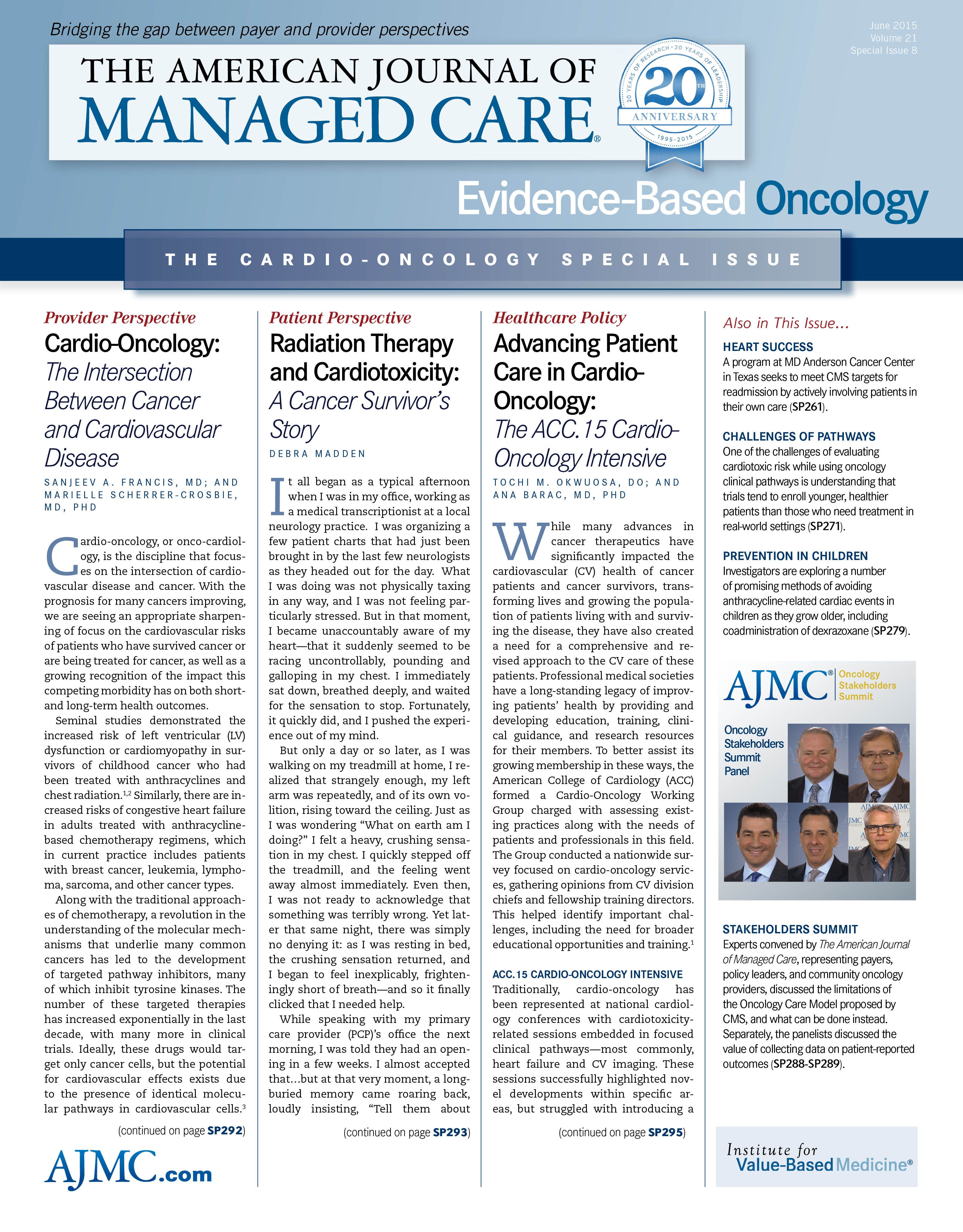Publication
Article
Evidence-Based Oncology
Session on Cardio-oncology Reflects Growing Number of Survivors
Author(s):
A session at the 64th Annual Scientific Session of the American College of Cardiology evaluated the cardiotoxic outcomes of treatment in cancer survivors.
There was a time when a cancer diagnosis brought a single-minded focus on fighting the disease, with less thought to quality of life afterward. But the sheer number of survivors—nearly 15 million in the United States, or 4% of the population has brought greater attention to ensuring that cancer treatment does not cause other harms, since cancer patients are not only living but living longer. The National Cancer Institute reports 41% of cancer survivors live 10 years or more, and 15% live 20 years or more.1
After secondary malignancies, cardiovascular (CV) issues are the leading cause of late morbidity and death among cancer survivors.2 The need for oncologists and cardiologists to be more proactive in developing strategies to work together to prevent heart problems for cancer patients and later, survivors was the force behind the half-day Cardio-oncology Intensive, which featured more than 60 presenters and panelists across 6 hours Monday at the 64th Annual Scientific Session of the American College of Cardiology.
The need for collaboration was summed up by Jean-Bertrand Durand, MD, medical director of Cardiomyopathy Services at MD Anderson Cancer Center in Houston, Texas, who told attendees that to be “fully engaged” every cardiologist should attend at least 1 cancer meeting a year. Bertrand was a co-author on a 2012 profile of a group of cancer survivors who took part in a Cardiovascular Prevention in Cancer Survivors clinic, which found that the mean vascular age was 8.4 years older than the mean chronological age.2 Some of the risk factors those patients faced are well-known: three-quarters had received anthracycline chemotherapy, while half had received radiation.2
Much can be done, however, in areas of prevention and diagnostics. Early presenters focused on more precise assessment of patient’s CV condition before proceeding with chemotherapy, on the use of molecular diagnostics in cancer treatment, which have reduced reliance on antracylcine chemotherapy, and better assessment of a patients CV and lipid profile before cancer therapy begins. Too often, presenters said, patients should have been taking cardioprotective therapies anyway for hypertension or diabetes.
Erica L. Mayer, MD, MPH, a breast oncologist from Dana Farber Cancer Institute said many years ago, treating a very young woman with anthracycline for triple negative breast cancer was a fairly straight forward decision. “It likely had substantial benefit,” and probably saved the woman’s life, she said.
Fast forward, Mayer said, and if the woman develops a second cancer, now her options are now much more limited. Today, weighing the risk-benefit ratio of cancer treatment with cancer survival offers many more choices, especially in age of precision medicine. Mayer said like many other oncologists, she uses the diagnostic test Oncotype Dx to determine which patients would not benefit from certain more toxic therapies, and overall the use of anthracyline has declined.
When tests offer prognostic and predictive information that the cancer will not respond to chemotherapy, she said, endocrine-based therapy is used instead.
Mayer said, however, that oncologists would benefit from more understanding of how biomarkers are changing the diagnostic process on the cardiology side, so that they would make more referrals instead of just ordering an echocardiogram. It’s time, she said, for the oncologist to partner with the cardiologist, “hopefully someone with knowledge of oncology, on how to best co-manage the care.”
During a discussion of cardioprotective strategies, exercise physiologist Lee Jones, PhD, of Memorial Sloan Kettering Cancer Center, emphasized the importance of getting an initial assessment of a patient before treatment starts. When he is asked, “How much should I exercise during chemo?” the answer in highly personal, because it depends on the patient’s activity level and condition before treatment began.
It’s not well understood, Jones said, that patients need exercise at different levels of intensity, and some low-intensity exercise is important and beneficial.
In discussing patient cases, presenters noted how often cancer patients arrived with underlying untreated diabetes or hypertension that had to be addressed. Not only do therapies like beta blockers provide treatment for cardiovascular issues, but some cited research that cancer patients taking beta blockers had improved survival.
References
1. Office of Cancer Survivorship. National Cancer Institute website. Statitics.
http://cancercontrol.cancer.gov/ocs/statistics/statistics.html
. Updated May 30, 2014. Accessed March 17, 2015.
2. Daher IN, Daigle TR, Bhatia N, Durand JB. The prevention of cardiovascular disease in cancer survivors. Tex Heart Inst. J. 2012;39(2):190-198.
Susan Dent, MD, a medical oncologist from Ottowa, Canada, said there is a great need to grow the evidence base on cardioprotective medications in cancer care. “There’s no consensus on what is the best approach," she said.






